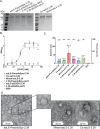One-Pot Expression and Assembly of Resurfaced Zika Virus E Domain III Nanoparticle Immunogens in Mammalian Cells
- PMID: 40547701
- PMCID: PMC12177739
- DOI: 10.1021/acsomega.5c03059
One-Pot Expression and Assembly of Resurfaced Zika Virus E Domain III Nanoparticle Immunogens in Mammalian Cells
Abstract
The presentation of antigens on self-assembling nanoparticles is a promising approach for augmenting the B-cell response of vaccines. In many cases, the nanoparticle and antigen are recombinantly expressed and purified separately prior to conjugation, requiring multiple steps that may be inefficient for large-scale production. Here, we describe a genetically encodable method and "one-pot" production of nanoparticle immunogens from mammalian cells. Our approach relies on the in situ assembly of the nanoparticle-antigen conjugate, between protein nanoparticles bearing SpyCatcher003 and antigen fused to SpyTag003, using simple cotransfection in mammalian cells, which can then be purified to homogeneity in a single step. We demonstrate this method with an antigen based on Zika virus E glycoprotein domain III ("rsZDIII-2.39") and compare the biochemical properties and immunogenicity in mice relative to genetic fusions. This work provides a framework for streamlining immunogen production and raises the possibility of employing such approaches for encoding nanoparticle immunogens as nucleic acid vaccines.
© 2025 The Authors. Published by American Chemical Society.
Figures




Similar articles
-
Immunogenicity and seroefficacy of pneumococcal conjugate vaccines: a systematic review and network meta-analysis.Health Technol Assess. 2024 Jul;28(34):1-109. doi: 10.3310/YWHA3079. Health Technol Assess. 2024. PMID: 39046101 Free PMC article.
-
Short-Term Memory Impairment.2024 Jun 8. In: StatPearls [Internet]. Treasure Island (FL): StatPearls Publishing; 2025 Jan–. 2024 Jun 8. In: StatPearls [Internet]. Treasure Island (FL): StatPearls Publishing; 2025 Jan–. PMID: 31424720 Free Books & Documents.
-
Sexual Harassment and Prevention Training.2024 Mar 29. In: StatPearls [Internet]. Treasure Island (FL): StatPearls Publishing; 2025 Jan–. 2024 Mar 29. In: StatPearls [Internet]. Treasure Island (FL): StatPearls Publishing; 2025 Jan–. PMID: 36508513 Free Books & Documents.
-
A New Measure of Quantified Social Health Is Associated With Levels of Discomfort, Capability, and Mental and General Health Among Patients Seeking Musculoskeletal Specialty Care.Clin Orthop Relat Res. 2025 Apr 1;483(4):647-663. doi: 10.1097/CORR.0000000000003394. Epub 2025 Feb 5. Clin Orthop Relat Res. 2025. PMID: 39915110
-
Assessing the comparative effects of interventions in COPD: a tutorial on network meta-analysis for clinicians.Respir Res. 2024 Dec 21;25(1):438. doi: 10.1186/s12931-024-03056-x. Respir Res. 2024. PMID: 39709425 Free PMC article. Review.
References
-
- Raja K., McDonald R., Tuck S., Rodriguez R., Milley B., Traquina P.. One-pot synthesis, purification, and formulation of bionanoparticle-CpG oligodeoxynucleotide hepatitis B surface antigen conjugate vaccine via tangential flow filtration. Bioconjug Chem. 2007;18(2):285–288. doi: 10.1021/bc060118q. - DOI - PubMed
-
- Ludwig J., Scally S. W., Costa G., Hoffmann S., Murugan R., Lossin J., Prieto K., Obraztsova A., Lobeto N., Franke-Fayard B.. et al. Glycosylated nanoparticle-based PfCSP vaccine confers long-lasting antibody responses and sterile protection in mouse malaria model. NPJ. Vaccines. 2023;8(1):52. doi: 10.1038/s41541-023-00653-7. - DOI - PMC - PubMed
-
- Cohen A. A., van Doremalen N., Greaney A. J., Andersen H., Sharma A., Starr T. N., Keeffe J. R., Fan C., Schulz J. E., Gnanapragasam P. N. P.. et al. Mosaic RBD nanoparticles protect against challenge by diverse sarbecoviruses in animal models. Science. 2022;377(6606):eabq0839. doi: 10.1126/science.abq0839. - DOI - PMC - PubMed
Grants and funding
LinkOut - more resources
Full Text Sources
